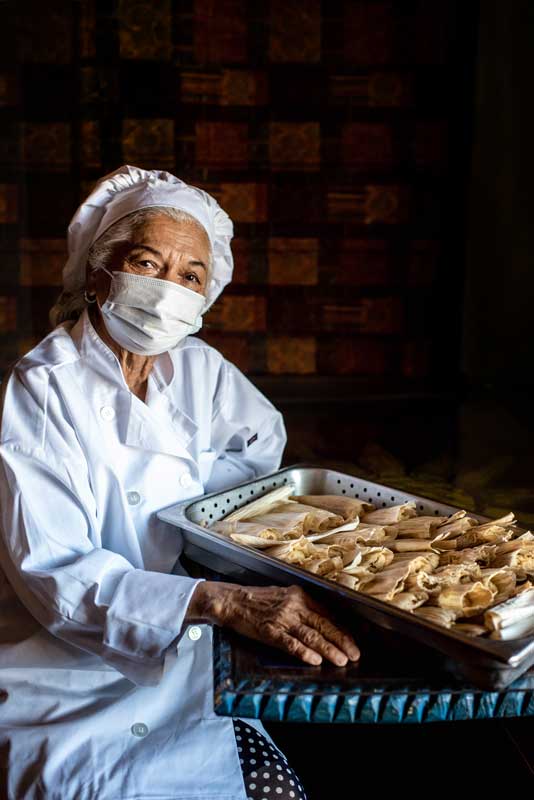A timeless tradition’s local roots.
Bertha Miranda, 78, opened her namesake Mexican restaurant and cantina in Reno 36 years ago, featuring culinary delights steeped in the traditions of her family’s Mexican heritage.
One of her favorite childhood dishes that patrons can find on the menu every day is tamales, made exactly the way Miranda remembers making them in her youth.
“The way we do it is the closest to the homemade tamales my family used to make in Mexico,” Miranda says. “But we don’t kill the pig. In those days, they killed the pig at 5 a.m.”
Family Secrets
The preparation of the pork, chicken, vegetarian, and sweet tamales Miranda sells, which her “family of staff” participates in, is an all-day affair, starting with processing corn through a mill to make scratch-made masa, a corn paste used for the base of the tamale.
“One of the secrets to making authentic tamales is making your own masa,” she says. “And for every 10 pounds of masa, I put one spoonful of baking powder to make them fluffy.”
Another secret Miranda is willing to share is that she does not add water to the masa. Instead, she uses the braising liquid from her pork or chicken filling to add an extra, savory layer of taste.
She braises her pork butt with medium-heat New Mexico chiles because, she says, “they have a special taste and good amount of spice.”
The veggie tamales are customized to each customer’s taste, but one requirement is that the vegetables, such as carrots and broccoli, are fresh and cooked in a small amount of corn oil.
“If people want cheese, that’s fine, too, but real tamales usually don’t have cheese,” she says.
Family Affair
The making of tamales is thought to have originated in the indigenous Mexican and Guatemalan culture and eventually spread to the rest of Latin America, where the recipes evolved to include Guatemalan Cambray tamales, made with sweet achiote paste; green tamales from Belize; and Caribbean tamales called pasteles, prepared with cooked, seasoned chicken or beef, as well as raisins, olives, capers, and seasonings. There also are unique varieties from Cuba, the Philippines, and Guam.
While recipes vary from country to country, the preparation of tamales usually is time consuming. It has become a long-standing tradition for families to come together and use this time to connect and catch up, especially during the holidays.
“I remember making tamales with my mother all the time when I was younger,” Miranda says. “Now I’ve been making tamales in the restaurant the last 36 years. I just love to cook and have fun in the kitchen.”
A Sweet Twist
If you are in the mood for something sweet, a twist on the traditional savory tamale, a sweet one might be for you.
Miranda makes her sweet tamales at the restaurant with her homemade masa and adds brown sugar, pecans, raisins, and anise.
“These are so good with your morning coffee or as a late-night snack,” she says.
Bertha Miranda’s Mexican Restaurant and Cantina
336 Mill St., Reno
775-786-9697 • Berthamirandas.com
Kymberly Drake is a Reno-based freelance writer with endless curiosity about food and drink and the sources that help bring it to our tables.
Sweet Tamales
(courtesy of Bertha Miranda, owner/chef, Bertha Miranda’s Mexican Restaurant in Reno. Makes 2 dozen)

Essential Utensils
1 large steamer pot with strainer
1 medium-sized saucepan
1 large, flat baking pan or mixing bowl
1 colander
1 regular tablespoon
Note: All ingredients can be found at most grocery stores, in the Hispanic foods or baking aisle, or your favorite Mexican specialty store.
5 pounds prepared corn masa dough
1½ pounds brown sugar cane
1 cinnamon stick
2 soup-sized spoonfuls vanilla extract
2 tablespoons anise seed
1 pound raisins
1 pound pecans, chopped (optional)
1 package (2 pounds) corn husks
In a saucepan, mix 1 cup water with brown sugar cane, cinnamon stick, and vanilla over medium heat for 5 minutes.
Once cooked and dissolved, add mixture to masa in a large, flat baking pan or mixing bowl and add raisins, anise seed, and pecans (if using).
Once all ingredients are mixed together into masa, let rest 15 minutes for flavors to marry.
Clean and rinse corn husks with water and place in colander to drain for 15 minutes.
Hold a corn husk flat in one hand, then spread 2 tablespoons of prepared masa evenly over husk. Fold and wrap corn husk three ways, leaving an opening at the top.
Add 1 quart of water to steamer pot, place strainer on top, and lay tamales diagonally inside the strainer with the openings facing up.
Once the pot is filled with tamales, cover with foil and a tight lid and cook for 45 minutes to 1 hour.
When fully cooked, remove corn husks and enjoy tamales with your favorite traditional Mexican drink, such as hot chocolate or coffee.


